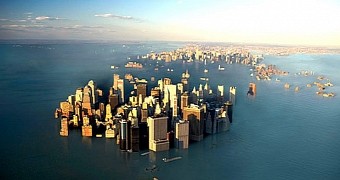In a recent paper, scientists warn that the global sea level could rise by as much as 1.8 meters (5.9 feet) by the end of the century. Should this happen, many coastal communities would be wiped out.
As explained by researchers with the Niels Bohr Institute and colleagues, sea level rise is an unavoidable phenomenon in the context of a warming climate.
Thus, the scientists say that, the higher average temperatures get as a result of climate change and global warming, the more water ice sheets and glaciers scattered all around the world stand to lose.
This water will eventually work its way into our planet's seas and oceans, causing them to rise, the scientists behind this research project write in the journal Environmental Research Letters.
Interestingly enough, it appears that our habit of pulling water from the underground and either drinking it or using it to keep crops alive is a contributor to sea level rise as well.
This is because, of the groundwater we access on a yearly basis, a significant amount eventually ends up in seas and oceans, EurekAlert explains.
The good news is that this frightening 1.8 meters sea level rise by the end of the century was documented in the case of a worst-case scenario. Thus, the likelihood for such an increase is less than 5%.
Then again, the Niels Bohr Institute scientists and fellow researchers say that seas and oceans around the world have high chances to rise by as much as 80 centimeters (31.4 inches) by the time this century comes to an end.
Although not as catastrophic as the sea level rise brought forth by a worst-case scenario, this 80 centimeters one would too upset coastal landscapes and threaten the lives of the people who inhabit them.

 14 DAY TRIAL //
14 DAY TRIAL //